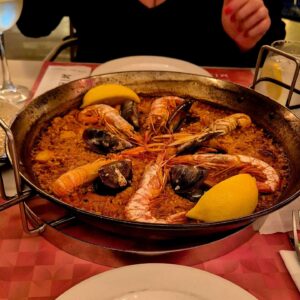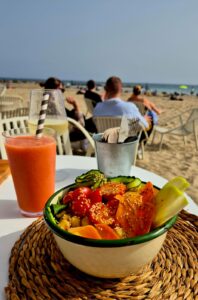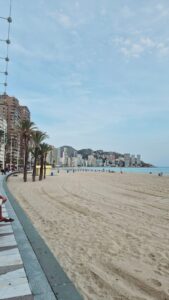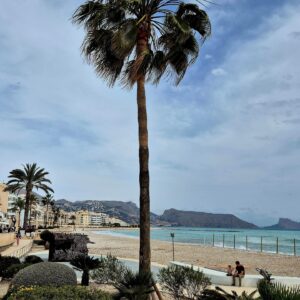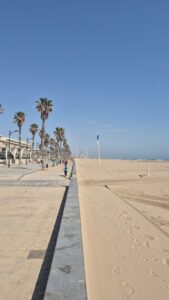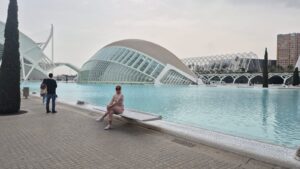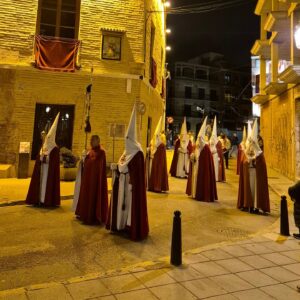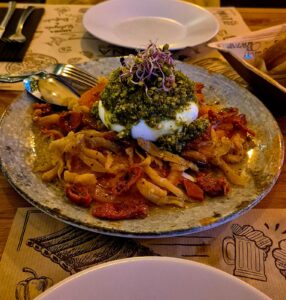Starting in Alicante: A Beachy Beginning That Didn’t Quite Click
My journey along Spain’s east coast began in Alicante, a sun-soaked city that’s incredibly popular with UK tourists — in fact, you can catch a flight there from nearly every major UK airport, almost any day of the week. It’s one of those destinations you hear about constantly, so naturally, I was curious to finally see what the buzz was about.
I visited in March, which is still very early spring — not quite beach season yet, but already much warmer than the UK. The sun was out most days, the air felt crisp and fresh, and there were just enough people around to keep things lively without being overcrowded. It’s a great time to visit if you prefer quieter streets and a more local atmosphere.
And yet… something didn’t quite click for me.
Yes, the beach is beautiful — long stretches of golden sand and warm waters make it an ideal place to relax, especially if you’re escaping the British weather. But beyond that, I found the vibe a bit underwhelming. It’s hard to explain why exactly. Maybe it was the heavy touristy feel, or maybe it just didn’t have the charm I was looking for. That said, everyone experiences places differently — and I know plenty of people who absolutely love Alicante.
Where I Stayed
I stayed in a hotel located quite centrally — comfortable, clean, and convenient for walking to most places. It wasn’t particularly memorable in terms of style or atmosphere, but it did the job. If I were to return, I might look for something more boutique or closer to the old town to really soak in the local charm.
What to Do in Alicante – Top Picks
If you’re planning to visit, there are definitely some gems to explore:
Castillo de Santa Bárbara – Perched high above the city, this historic fortress offers panoramic views and a bit of a workout if you hike up (though there’s also a lift!). Sunset from the top is worth the effort.
Explanada de España – A gorgeous palm-lined promenade, perfect for a sunset stroll with a gelato in hand. Great for people-watching too.
Playa del Postiguet – Alicante’s main beach, super accessible and great for a lazy afternoon in the sun.
Mercado Central – For local food, fresh produce, and a glimpse of daily life. Grab a fresh pastry and a café con leche and feel like a local.
El Barrio – The old town, filled with charming alleyways, tapas bars, and vibrant nightlife. This is where Alicante comes alive after dark.
Where to Stay – Quick Tips
Best for first-timers: Stay near the old town (El Barrio) for a mix of culture, food, and nightlife.
Best for beach lovers: Choose accommodation close to Playa del Postiguet or Alicante Marina.
On a budget: Look for places in the San Antón or Carolinas districts — affordable and still walkable.
Final Thoughts on Alicante
While Alicante didn’t completely win me over, it was still a relaxing place to start my journey — a soft landing spot that gave me a chance to slow down, soak up some sun, and ease into the rhythm of the road. And sometimes that’s all you really need from a first stop.
As I packed up and headed toward Benidorm, I was already feeling more excited. I had a sense that the road ahead might hold the kind of surprises and sparks I’d been hoping for.
Benidorm: A Surprising Coastal Gem with Contrasts
After my time in Alicante, I made a brief stop in Benidorm—a destination often associated with package holidays and a certain British charm. While I had only a day to explore, the city offered some unexpected delights alongside its well-known reputation.
First Impressions: A Blend of Beauty and Bustle
Benidorm is renowned for its stunning beaches, and they did not disappoint. The Playa de Levante, with its golden sands and clear waters, was impeccably clean and inviting. The juxtaposition of modern skyscrapers against the Mediterranean backdrop created a unique coastal skyline that was both impressive and picturesque.
However, the city’s ambiance was a mix of vibrant energy and tourist-centric hustle. Known for its lively nightlife and as a hotspot for British tourists, Benidorm has a reputation for being a party town. While this atmosphere appeals to many, I found it a bit overwhelming, especially as someone seeking a more authentic and tranquil experience.
A Brief Exploration: Discovering the City’s Charms
During my short visit, I wandered through the Old Town, with its narrow streets and traditional Spanish architecture. The Balcón del Mediterráneo, a beautiful viewpoint, offered panoramic views of the sea and was a highlight of my walk.
Despite the city’s bustling nature, these pockets of charm provided a glimpse into Benidorm’s rich history and culture.
Tips for Solo Female Travelers
For those considering a solo trip to Benidorm, here are some tips to ensure a safe and enjoyable experience:
Accommodation: Opt for well-reviewed hotels in central areas to stay close to main attractions and avoid isolated spots.
Safety: While Benidorm is generally safe, it’s advisable to avoid certain areas like Calle Gerona late at night, as they can be hotspots for pickpocketing and rowdy behavior .
Transportation: The city is pedestrian-friendly, but for longer distances, consider using the reliable bus and tram networks. Hiring a bike is also a great way to explore the coastline .
Activities: For a more serene experience, visit Poniente Beach, which is quieter than its counterpart, Levante. Exploring the Serra Gelada Natural Park offers scenic hikes and a break from the city’s hustle .
Final Thoughts: A City of Contrasts
Benidorm surprised me with its beautiful beaches and striking architecture, but the overall vibe was more lively and tourist-oriented than I prefer. While I appreciated the city’s offerings, I found myself yearning for destinations with a more authentic and relaxed atmosphere.
Altea: Spain’s Whitewashed Gem That Feels Like a Slice of Greece
After the vibrant energy of Benidorm, my journey led me to Altea, a serene coastal town that felt like stepping into a Mediterranean dream. Often referred to as the “Santorini of Spain,” Altea’s charm lies in its whitewashed buildings, cobblestone streets, and the iconic blue-domed church that crowns the hilltop .
A Town That Captivates the Senses
Altea’s Old Town is a labyrinth of narrow alleys, each turn revealing artisanal shops, quaint cafes, and vibrant bougainvillaea cascading down the walls. The climb uphill is rewarded with panoramic views of the Mediterranean, making it a haven for photographers and romantics alike.
One of the town’s highlights is the Iglesia de Nuestra Señora del Consuelo, known for its striking blue and white tiled dome. This church not only serves as a spiritual center but also as a symbol of Altea’s rich cultural tapestry .
A Rich Tapestry of History and Art
Altea’s history is a mosaic of civilizations. From Iberians and Romans to Moors and Christians, each has left an indelible mark on the town’s architecture and culture . In the 20th century, Altea became a magnet for artists and writers, further enriching its cultural landscape .
For art enthusiasts, the Palau Altea offers a range of exhibitions and performances, reflecting the town’s ongoing commitment to the arts .
Beaches and Natural Beauty
While Altea’s beaches may not have the fine sand of other coastal towns, their pebble shores and crystal-clear waters offer a unique charm. Playa de la Roda is the most accessible, located near the town center, while Playa de la Olla offers a quieter retreat .
For nature lovers, the nearby Sierra de Bernia provides hiking trails with breathtaking views, and the Algar Waterfalls are a short drive away, offering a refreshing escape into nature .
Tips for Solo Female Travelers
Altea is considered a safe and welcoming destination for solo female travelers. The town’s friendly locals and laid-back atmosphere make it easy to navigate and enjoy at your own pace.
Stay Connected: While Altea is generally safe, it’s always good to let someone know your plans for the day.
Evening Strolls: The town comes alive in the evenings with street performers and open-air cafes. Enjoy the ambiance, but always stay aware of your surroundings.
Local Cuisine: Don’t miss out on trying local dishes like paella or tapas at family-run restaurants. Dining alone is common and welcomed here.
Personal Reflections
Altea was a refreshing contrast to the bustling streets of Benidorm. The town’s authentic charm, artistic soul, and breathtaking views made it one of my favorite stops. It felt like a place where time slows down, allowing you to truly soak in the beauty around you.
Calpe, Spain: Towering Rocks, Coastal Views, and Hidden Delights
Calpe (or Calp in Valencian) was one of those unexpected highlights of my Costa Blanca journey—even though I didn’t get to stay long or make it to the beach. We only stopped briefly, but the moment I saw the iconic Peñón de Ifach rising dramatically from the sea, I was amazed. The rock, often referred to as the “Gibraltar of the North,” makes Calpe’s coastline truly unforgettable.
The town itself looked stunning—modern buildings, palm-lined promenades, and Mediterranean architecture blending into the landscape. It made me wish I had more time there. Calpe gives off a peaceful, clean, and stylish vibe, and you instantly sense there’s more beneath the surface, from its fishing roots to its vibrant local life.
A Quick Look at Calpe’s Charm
Calpe is known for its picturesque beaches like Playa de la Fossa and Arenal-Bol—long stretches of soft sand and turquoise water, perfect for sunbathing or a solo swim. The town also has a charming old quarter with narrow, cobbled streets and colorful murals. It’s a great place for a relaxed wander with a camera in hand.
If you’re into hiking, the Peñón de Ifach Natural Park offers a challenging but rewarding climb with panoramic views of the Costa Blanca. On clear days, you can even see Ibiza in the distance.
Interesting Facts & History
- Calpe has Roman roots, and you can still visit the Baños de la Reina (Queen’s Baths), ancient saltwater pools carved into the rocks by the sea.
- Historically a fishing village, Calpe still has a working fish market where you can see the daily catch being auctioned.
- The Peñón de Ifach is actually a huge limestone outcrop that’s over 300 meters high and home to many species of birds and plants.
Tips for Solo Female Travellers
- Safe and welcoming: Calpe is considered safe and relaxed, with friendly locals and a calm atmosphere, especially compared to party-heavy towns like Benidorm.
- Perfect for a stopover: Even if you don’t stay the night, it’s worth visiting for the views alone.
- Wear good walking shoes if you want to explore the old town or venture toward the Peñón.
- Local eats: Try the arroz a banda (a local rice dish cooked in fish stock), and don’t skip the fresh seafood near the port.
Even though my time in Calpe was short, it definitely left an impression. If you’re planning a Costa Blanca road trip, make sure to include a stop in this beautiful coastal town—you might end up wanting to stay longer too.
Valencia: A City of Contrasts and Coastal Charm
Valencia was the culmination of my journey along Spain’s eastern coast, and it did not disappoint. Spending a few days here allowed me to immerse myself in the city’s vibrant culture, delectable cuisine, and architectural wonders.
Embracing the Beach Vibes
One of the highlights of my stay was the beach. In the evenings, locals and visitors alike gathered along the shore, creating a lively and welcoming atmosphere. The sense of community and the simple joy of watching the sunset over the Mediterranean made for unforgettable moments. The beach life in Valencia really stands out—not just as a place to sunbathe, but as a hub where people meet, share food, music, and laughter.
Exploring the City of Arts and Sciences
A must-visit in Valencia is the City of Arts and Sciences (Ciutat de les Arts i les Ciències), a futuristic complex designed by architect Santiago Calatrava. This architectural marvel includes several notable structures:
L’Hemisfèric: An IMAX cinema and planetarium shaped like a giant eye.
Museu de les Ciències Príncipe Felipe: A science museum resembling a whale’s skeleton, offering interactive exhibits.
L’Oceanogràfic: Europe’s largest aquarium, home to an incredible range of marine species.
Palau de les Arts Reina Sofía: An opera house and performing arts center with an unmistakable flowing design.
Wandering through this area felt like stepping into a sci-fi movie set. It’s one of those places where modern design and imagination truly come to life.
Culinary Delights
Valencia is the birthplace of paella, and tasting an authentic, freshly cooked one here is a must. But the culinary highlight of my trip was the tapas—we had some of the most amazing tapas I’ve ever tried. Each small plate was full of flavor, and paired with local wine or a cold beer, it was a perfect way to wind down after sightseeing.
One memorable experience was dining at a family-run eatery near the beach. The atmosphere was warm and welcoming, and the food was exceptional. I tried Patatas Bravas for the first time in my life, and they were so good—crispy on the outside, tender on the inside, and topped with a spicy, flavorful sauce. I would highly recommend this place to anyone seeking an authentic culinary experience.
Because I visited Valencia in early spring (March), the city still had a very local, authentic vibe. There weren’t many tourists, so I could experience the city more like a local—from quiet strolls through historic streets to enjoying leisurely meals surrounded by native Valencians. That genuine atmosphere made a big difference and made me appreciate the place even more.
Experiencing Semana Santa Marinera
During my visit in March, I encountered a unique and profound cultural event: Semana Santa Marinera, or Maritime Holy Week. This celebration is distinctive to Valencia, particularly in the seaside districts of Cabanyal, Canyamelar, and Grao. The streets came alive with processions, music, and a deep sense of tradition.
What struck me most were the participants dressed in conical hoods and robes, known as capirotes. At first glance, their appearance was startling, but I learned that these garments have deep religious significance. The pointed hoods are worn by members of religious brotherhoods, or cofradías, symbolizing penance and humility. The attire dates back centuries and is meant to anonymize the wearers as they reflect on their faith and seek spiritual renewal .
The processions were both solemn and vibrant, featuring elaborately decorated floats, or pasos, depicting scenes from the Passion of Christ. The community’s involvement was heartfelt, with residents even transforming their homes into temporary chapels to honor various saints . Witnessing this event provided a profound insight into Valencia’s cultural and religious heritage.
Tips for Solo Female Travelers
Stay Connected: Valencia is a safe city overall, but keeping someone updated on your whereabouts is always a good habit when traveling alone.
Use Public Transport: The metro and bus systems are easy to use and well-connected, ideal for solo navigation.
Try a Tapas Tour: A food tour is a great way to meet people while tasting the best of the city.
Enjoy the Beach at Sunset: It’s safe, social, and truly one of the most memorable experiences of the city.
Valencia’s mix of modern and old, beach and city, calm and energy, creates a uniquely Spanish rhythm that is hard to resist. Whether you come for the architecture, the cuisine, or simply to relax—it’s a city that welcomes you with open arms.


